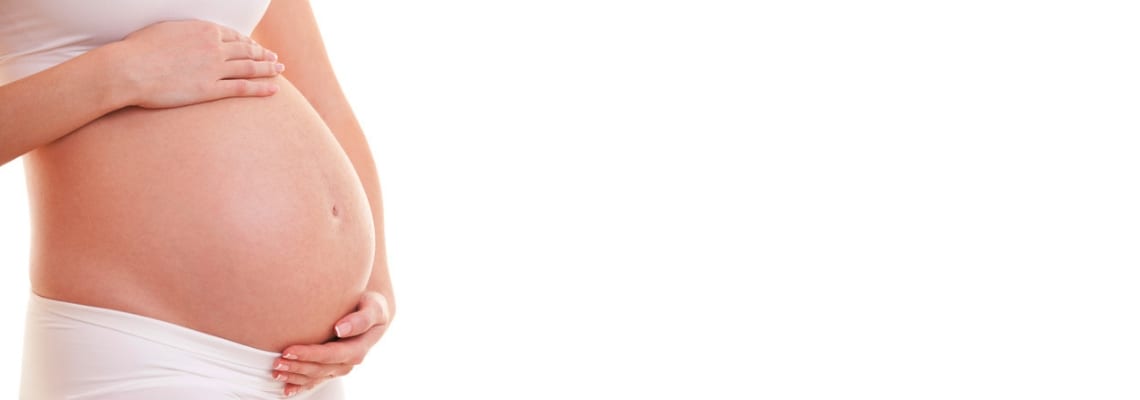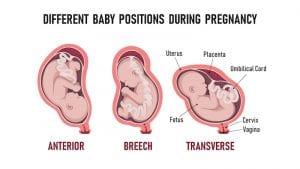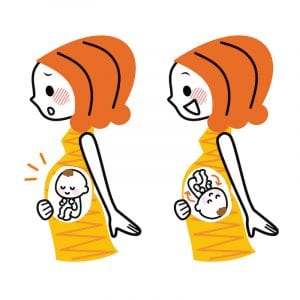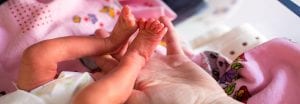
There are many different positions that your baby might be in through pregnancy within the womb. However, when it comes to birth there is an optimal position for your baby to be in to make the birthing process go that much smoother.
The Ideal Position for Childbirth
The ideal position for your baby to be in is head down and facing your back, this means that their tummy is facing your spine. This is known as the occipito- anterior position.
Having your baby in this position will help to allow the baby to move through the pelvis more easily. Your baby will fit snugly into the curve of your pelvis. Once labor progresses they will curl their head back and tuck their chin into their chest in order to move out of your body.
The head of the baby is the heaviest part of their body, so it will naturally want to move toward the lowest part of the abdomen and uterus like gravity. The top of your baby’s head will also press and apply pressure against your cervix, which will help to open and dilate your cervix for labor to progress.
All this has many benefits for you and your baby. If your baby is in an anterior position, you’re more likely to:have a quicker labor and birth, give birth without needing an induction or c-section, as well as need less pain relief during the birthing process.
If the baby’s body does come out first then the cervix may not be stretched enough to allow for the head to pass through it. This could be life threatening for the baby and should be avoided if possible.
Other Positions that May Be In
 Another position that your baby could be in is called the occipito-posterior position. This is when your baby is head down, but their face is positioned toward your stomach instead towards your back. About one third of babies are in this position within the first stages of labor. However, they will spontaneously turn themselves to face towards your back before the pushing begins. If the baby does not turn this position has been known to cause back labor.
Another position that your baby could be in is called the occipito-posterior position. This is when your baby is head down, but their face is positioned toward your stomach instead towards your back. About one third of babies are in this position within the first stages of labor. However, they will spontaneously turn themselves to face towards your back before the pushing begins. If the baby does not turn this position has been known to cause back labor.
Your baby may also be in a position known as the Breech position. This is when the baby has their feet or butt down instead of their head. This position is not ideal for childbirth and unless the baby can be flipped will usually result in a c-section.
A transverse lie is when the baby is lying horizontally within the uterus. This position is usually rare during delivery because most babies will adjust themselves before. If they do not move out of this position then a cesarean delivery will occur because of a slight risk to having the umbilical cord prolapse when the water breaks. This is where the cord comes out of the womb before the baby does.
How to Naturally Reposition Baby for Birth
When it comes to naturally repositioning your baby, gravity is your best friend. Gravity will help to push your baby along to where they need to be.
Here are some helpful hints to coax your baby into the correct position for childbirth:
- When you sit down try to tilt your pelvis forward instead of backwards.
- Spend a lot of time sitting on your birthing ball.
- If your job requires you to do a lot of sitting, make sure to stay active and move around throughout the day.
- Try to make sure that your hips are always higher than your knees when you sit.
- Try to get on your hands and knees, as if you are scrubbing the floor, a few minutes at a time daily.
- Don’t panic! Most babies will reposition themselves before labor begins, try not to worry too much if you can.
- Try to avoid the following positions if possible: deep squats, crossing your legs, sitting with your feet raised, and leaning back into a sofa or armchair.
- Sleep on your left side as this will encourage the baby to move into the right position and provide more blood flow to you and the baby.
- Swim with your belly facing downwards to encourage baby to move down.
- Take lots of walks near the end of your pregnancy especially to help gravity run its course with baby.
- Try to keep your shoulders back and walk briskly.
Transverse Babies
The Forward-Leaning Inversion is an exercise that will help to turn both a transverse and breech baby into the correct position. This exercise is extremely helpful to begin within the last few weeks of pregnancy from 34 to 37 weeks.
To begin, bend down or lean over the edge of your couch. Carefully begin to first get down on your hand then slowly shift your weight to your forearm. Try to keep your elbows out and your hands close by. Do not let your head rest on the floor, as this could cause a strain on your neck. Your hips should be approximately 10- 20 inches above your arms and shoulders and your belly should be hanging off of the side of the couch. Stay in this position with your chin tucked and your head hanging free for five minutes. Once five minutes has passed you can carefully make your way out of this position onto all floors. You can do this by holding something firm as you stand up. Repeat this exercise twice a day.
If five minutes at a time is too much for you, then do this position for 30 to 60 seconds. After this time has passed crawl off the side of the couch, bring one knee down to the other and sit up to catch your breath. Then repeat.
Breech Babies
 One of the best exercises that you can to do to reposition a breech baby is the Breech Tilt. In order to do this you must place a pillow at a low edge against a couch or seat. Then, with the help of your partner, lie down with your head down and feet up position. After you are in this position, gently massage your stomach in a circular downward motion. You can even place an ice pack wrapped in a thin cloth against your baby’s head. This will help to motivate the baby to move in the opposite direction where it is warmer. By being upside down and massaging your stomach this will encourage them to move easily.
One of the best exercises that you can to do to reposition a breech baby is the Breech Tilt. In order to do this you must place a pillow at a low edge against a couch or seat. Then, with the help of your partner, lie down with your head down and feet up position. After you are in this position, gently massage your stomach in a circular downward motion. You can even place an ice pack wrapped in a thin cloth against your baby’s head. This will help to motivate the baby to move in the opposite direction where it is warmer. By being upside down and massaging your stomach this will encourage them to move easily.
You can also have your partner speak to the baby through a cardboard tube placed near your pubic bone. This can encourage the baby to move towards the sound. Try doing this position for up to 20 minutes at a time, three times daily.
Keep in Mind
If at any point during these exercises you feel dizzy, nauseous, or contractions stop immediately. You may fall and avoiding this will help to avoid any injury to you or the baby. Never attempt to manually turn the baby with your hands as this could cause harm to the baby.
Your doctor knows what is best for you and your baby in the end. Try not to panic or worry too much when it comes to positioning as they will help you throughout the course of your pregnancy and delivery.


